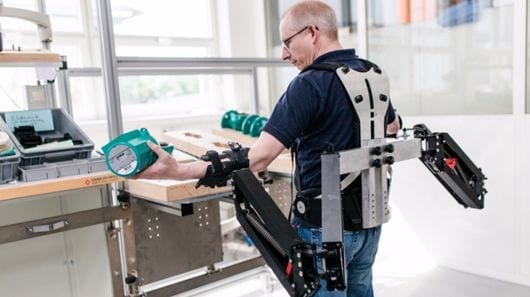
Photo by
L. Brian Stauffer
University of Illinois postdoctoral researcher Prabuddha Mukherjee, left, bioengineering professors Rohit Bhargava and Dipanjan Pan, and postdoctoral researcher Santosh Misra report the development of a new class of carbon nanoparticles for biomedical use.
Researchers have found an easy way to produce carbon nanoparticles that are small enough to evade the body’s immune system, reflect light in the near-infrared range for easy detection, and carry payloads of pharmaceutical drugs to targeted tissues.
Unlike other methods of making carbon nanoparticles – which require expensive equipment and purification processes that can take days – the new approach generates the particles in a few hours and uses only a handful of ingredients, including store-bought molasses.
The researchers, led by University of Illinois bioengineering professors Dipanjan Pan and Rohit Bhargava, report their findings in the journal Small.
“If you have a microwave and honey or molasses, you can pretty much make these particles at home,” Pan said. “You just mix them together and cook it for a few minutes, and you get something that looks like char, but that is nanoparticles with high luminescence. This is one of the simplest systems that we can think of. It is safe and highly scalable for eventual clinical use.”
These “next-generation” carbon spheres have several attractive properties, the researchers found. They naturally scatter light in a manner that makes them easy to differentiate from human tissues, eliminating the need for added dyes or fluorescing molecules to help detect them in the body.
The nanoparticles are coated with polymers that fine-tune their optical properties and their rate of degradation in the body. The polymers can be loaded with drugs that are gradually released.
The nanoparticles also can be made quite small, less than eight nanometers in diameter (a human hair is 80,000 to 100,000 nanometers thick).
“Our immune system fails to recognize anything under 10 nanometers,” Pan said. “So, these tiny particles are kind of camouflaged, I would say; they are hiding from the human immune system.”
The team tested the therapeutic potential of the nanoparticles by loading them with an anti-melanoma drug and mixing them in a topical solution that was applied to pig skin.
Bhargava’s laboratory used vibrational spectroscopic techniques to identify the molecular structure of the nanoparticles and their cargo.
“Raman and infrared spectroscopy are the two tools that one uses to see molecular structure,” Bhargava said. “We think we coated this particle with a specific polymer and with specific drug-loading – but did we really? We use spectroscopy to confirm the formulation as well as visualize the delivery of the particles and drug molecules.”
The team found that the nanoparticles did not release the drug payload at room temperature, but at body temperature began to release the anti-cancer drug. The researchers also determined which topical applications penetrated the skin to a desired depth.
In further experiments, the researchers found they could alter the infusion of the particles into melanoma cells by adjusting the polymer coatings. Imaging confirmed that the infused cells began to swell, a sign of impending cell death.
“This is a versatile platform to carry a multitude of drugs – for melanoma, for other kinds of cancers and for other diseases,” Bhargava said. “You can coat it with different polymers to give it a different optical response. You can load it with two drugs, or three, or four, so you can do multidrug therapy with the same particles.”
Read more: Biomedical breakthrough: Carbon nanoparticles you can make at home
The Latest on: Biomedical carbon nanoparticles
[google_news title=”” keyword=”Biomedical carbon nanoparticles” num_posts=”10″ blurb_length=”0″ show_thumb=”left”]
via Google News
The Latest on: Biomedical carbon nanoparticles
- Biomedical Engineer Salaryon April 29, 2024 at 5:00 pm
How Much Does a Biomedical Engineer Make? Biomedical Engineers made a median salary of $99,550 in 2022. The best-paid 25% made $129,230 that year, while the lowest-paid 25% made $78,500.
- Biomedical technology newson April 29, 2024 at 5:00 pm
A research team led by Professor Sohee Kim of the Department of Robotics and Mechatronics Engineering in the Daegu Gyeongbuk Institute of Science & Technology has successfully developed three ...
- Nanoparticles and the Blood Coagulation Systemon April 27, 2024 at 5:00 pm
As such, nanoparticles are rapidly entering various areas of industry, biology and medicine. The benefits of using nanotechnology for industrial and biomedical applications are often tempered by ...
- Biomedical Sciences Bachelor of Science Degreeon April 18, 2024 at 5:00 pm
RIT’s biomedical sciences BS consists of life sciences core courses combined with flexible electives to customize your degree for medical school or full-time employment. Our biomedical sciences degree ...
- Biomedical engineering articles from across Nature Portfolioon April 7, 2024 at 5:00 pm
Biomedical engineering is a branch of engineering that applies principles and design concepts of engineering to healthcare. Biomedical engineers deal with medical devices such as imaging equipment ...
- Novel high entropy alloy nanoparticle catalysts for growing high-density carbon nanotubeson April 3, 2024 at 12:31 pm
HEA nanoparticles (NPs) have been extensively studied for their catalytic potential. However, despite their potential, HEA NPs have never been used as catalysts for growing single-walled carbon ...
- Carbon Nanomaterials: Versatile Building Blocks for Nanotechnologyon March 31, 2024 at 8:00 pm
Fullerenes have unique electronic and optical properties and find applications in solar cells, drug delivery, and biomedical imaging. Carbon dots are small, quasi-spherical nanoparticles with ...
- Harnessing the Power of Microalgae-Material Hybrids Paving the Way to Carbon Neutralityon March 26, 2024 at 3:27 am
In the quest for sustainable solutions to mitigate climate change and achieve carbon neutrality, researchers are turning to nature’s biological systems for inspiration. Among these systems, microalgae ...
- Applied Biomedical Sciences Majoron June 25, 2023 at 7:02 am
As an applied biomedical sciences major, you will be prepared for a broad range of employment and professional education opportunities in health care. The degree ...
- Biomedical Engineeringon February 8, 2023 at 3:57 am
The School of Biomedical Engineering is a collaborative effort of the Faculty of Medicine and the Faculty of Engineering. The program has a particular interest in biomedical devices innovation.
via Bing News










